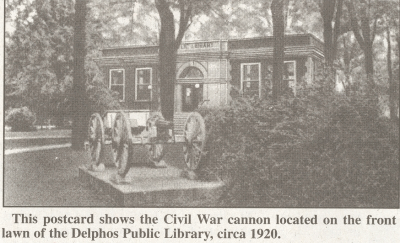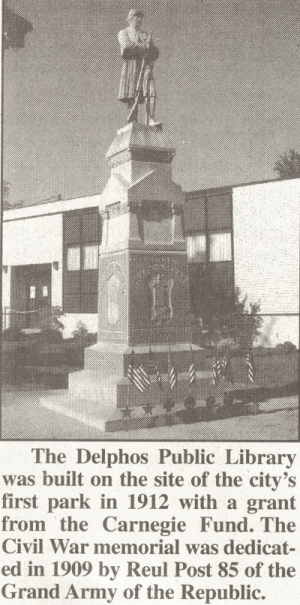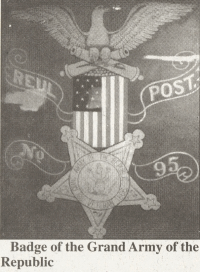
Window to the Past
History of Civil War Cannon in Delphos
By BOB HOLDGREVE
Recently I found the history of the Civil War cannon that set on the grounds of the Delphos Public. Library and was moved to the American Legion grounds on State Street, and then was later sold.
From the Delphos Herald, Oct. 1, 1930
Aplon Lechleitner, who died Monday, last member of Green Squad which had charge of cannon brought to Delphos after Civil War and now located in Library Park.
The death of Aplon Lechleitner, who passed away at Ft. Wayne Monday, recalls to some of the older residents some of the interesting incidents in the life of this city in the early days.
Mr. Lechleitner, a veteran of the Civil War, was a member of a gun squad of five which was formed to take charge of a cannon which was secured for Delphos following the Civil War, a reminder of the grim battle between the North and South. This is a one-pounder which was used throughout the war.
This gun was secured through the efforts of George W. Hunt, Isaac Scott, R.W. Lythe, John Feely and Henry Moennig. These men paid the expense of bringing the gun to Delphos and owned it jointly, ownership passing to those remaining upon the death of any of the five.
Mr. Moennig was the last of the five to pass away and gave the gun to the City of Delphos.
The gun squad which was formed to have charge of the cannon consisted of Fred Rauschart, John Clapper, James Point, J. McLaughlin and Aplon Lechleitner.
These men fired it many times upon occasions of elections and other times of general interest. It finally became unsafe to fire it and this practice ceased.
Information concerning the history of the gun and those who brought it to Delphos and handled it here was received from John Wahmhoff, local historian and curator of the museum at the public library.
More Civil War News
Unmarked Soldiers Graves
The following is a list of soldiers graves unmarked in Allen County, as reported to the Adjutant-General: Jacob Bussart, Co. A, 74th O.V.I. killed at Murfreesboro, buried in Berryhill's Cemetery on Sugar Creek, Bath Township, on John Miller's farm; William McGraw, Corporal, Co. A. 118th O.V.I., buried in the Catholic Cemetery, Lima; Alexander B. Maxwell, Co. A. 118th O.V.I., buried in township cemetery, Lima; Nathaniel G. Franklin, Co. B. 81st O.V.I., buried in the Daniels graveyard near Perry Chapel, Perry Township; Ancel Basset Caddy, member of McAllister's Battery, died at Fort Donaldson, Tenn., March 3, 1862, buried in Lima Cemetery; Robert Dyer Caddy, Captain Co. C, 90th O.V.I. killed at Chickamauga, Tenn., Sept. 20, 1863; Patrick May, Co. C, McLoughlin Squadron, buried in Baptist graveyard, Armstrong's Mills; and Francis M. Armon, Co. B., 8lst, O.V.I., buried in Baptist graveyard, Armstrong's Mills.
Feb. 21, 1878 Delphos Herald
There is no cooler man than your simple fellow. While General Thomas was inspecting the fortress at the Chattanooga with General Garfield, they heard someone shout: "Hellow, mister! You! I want to speak to you!" General Thomas, turning, found he was the "mister" so politely hailed by an East Tennessee soldier.
"Well my man" said the General, "what do you want with me?"
"I want to get a furlough, mister, that's what 1 want," was the reply.
"Why do you want a furlough, my man?" inquired the general.
"Well I want to go home and see my wife."
"How long is it since you saw her?"
"Ever since I enlisted; nigh on to three months."
"Three months!" exclaimed the commander. "Why, my good fellow I have not seen my wife for three years!"
The Tennessean looked incredulous and drawled, "Well, you see, me and my wife ain't that sort!"
April 11, 1878 Delphos Herald
A soldier who served in the swamps of South Carolina during the Civil War tells the following story: Among the officers who I remember at Morris Island was Col. Sewell of New York, a most excellent officer and an accomplished engineer, Col. Sewell was engaged on the Swamp Angel, and being very energetic himself, he was not afraid to enter swamps. His surprise can be imagined when one day one of his lieutenants whom he had ordered to take twenty men and enter the swamp, said he could not do it.
"And why, sir, can't you do it?" cried the energetic Sewell.
"The mud is too deep, Colonel," replied the Lieutenant.
"You can at least try," said Sewell.
The Lieutenant did so and in an hour returned, his men covered with mud from head to foot.
"Here, now," cried Sewell, "what brings you back?"
"Colonel, the mud is over my men's heads, I can't do it."
"Oh! but you can make a requisition for anything that is necessary for the safe passage of the swamp, and I will give it to you, but you must go through it."
The Lieutenant did make a requisition in writing, which was as follows: "I want twenty men, eighteen feet tall to cross a swamp fifteen feet deep."
The joke was a good one, but Sewell was terribly in earnest, could not appreciate it and promptly arrested the Lieutenant for disrespect to his superior officer. Another Lieutenant was detailed and he went to the swamp, had his men fell the timber and accomplished what his unfortunate predecessor had failed to do. Col. Sewell built his battery with the aid of wheel borrows and sand, and the remains of it still stand as a monument to his energy and skill as an engineer.
June 24, 1880 Delphos Herald
Among the new industries developed by the Civil War, that of gathering lead from Southern battlefields, is a novel one. Nearly a half-million pounds of lead bullets have been gathered near Marietta, Ga., and sold.
Aug. 9, 1878 Delphos Herald
Benefit of G.A.R. Monument Fund
The Tourists have made arrangements with Rev. J. W. Holland of Upper Sandusky, formerly a pastor in Delphos for the Methodist congregation, to give his illustrated stereopticon lecture Tuesday evening at the Methodist church. The subject will be "The World's Masterpieces in Painting and Sculpture." In addition, he will give scenes covering patriotic subjects and views of the American Generals of the Civil War. The net results will be donated to the G.A.R. of Delphos to be placed in the Monument fund, which will pay for the Monument that will be erected in the park.
The prices of admission will be adults, 15 cents; children, 10 cents. The prices are low and the venture should be well patronized, as the money realized will be used for a noble purpose.
Nov. 5, 1908 Delphos Herald
The G.A.R. monument was erected in 1909 by Scherger Monuments of Delphos. It was dedicated June 1, 1909, by the Reul Post No. 85 of the Grand Army of the Republic. It was 3 years later that the Delphos Public Library was built at this site which was Delphos' first park.
(The Delphos Canal Commission Museum has several large posters of the Reul Post G.A.R. – R.H.)
Delphos resident Mr. and Mrs. Henry Hodde and Minor Long have returned from the G.A.R. encampment near Louieville, Ky.
Oct. 1895 Delphos Herald
The charge of Pickett's division in the battle of Gettysburg has often been described by war correspondents and others who witnessed the memorable conflict, but perhaps no one has more correctly portrayed the situation then General Longstreet, who said the following:
Pickett said to me: 'General shall I advance?' My feelings had so overcome me that I did not speak, for fear of betraying my want of confidence to him. I bowed my affirmation, and turned to mount my horse. Pickett immediately said, 'I shall lead my division foreword sir.' I spurred my horse to the woods, where Alexander was stationed with artillery. When I reached him, he told me of the disappearance of the seven guns which were to have led the charge with Pickett, and that his ammunition was so low that he could not properly support the charge. I at once ordered him to stop Pickett until the ammunition was replenished. He informed me that he had no ammunition to replenish. I then saw there was no help for it, and that Pickett must advance under his orders. He swept past our artillery in splendid style, and the men marched steadily and compactly down the slope. As they started up the ridge, over one hundred cannon from the breastworks of the Federals hurled a rain of canister, grape and shell down upon them; still they pressed on until half way up the slope, when the crest of the hill was lit up with a solid sheet of flame, as the masses of infantry rose and fired. When the smoke cleared away, Pickett's division was gone. Nearly two-thirds of his men lay dead on the field, and the survivors were sullenly retreating down the hill. Mortal men could not have stood that fire. In half an hour the contested field was cleared, and the battle of Gettysburg was over."
Jan. 17, 1878 Delphos Herald



Compiled by Robert Holdgreve
Delphos Historical Society
October 18, 2003 Delphos Herald Newspaper